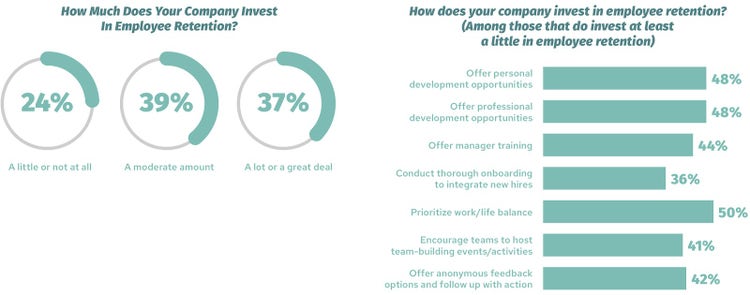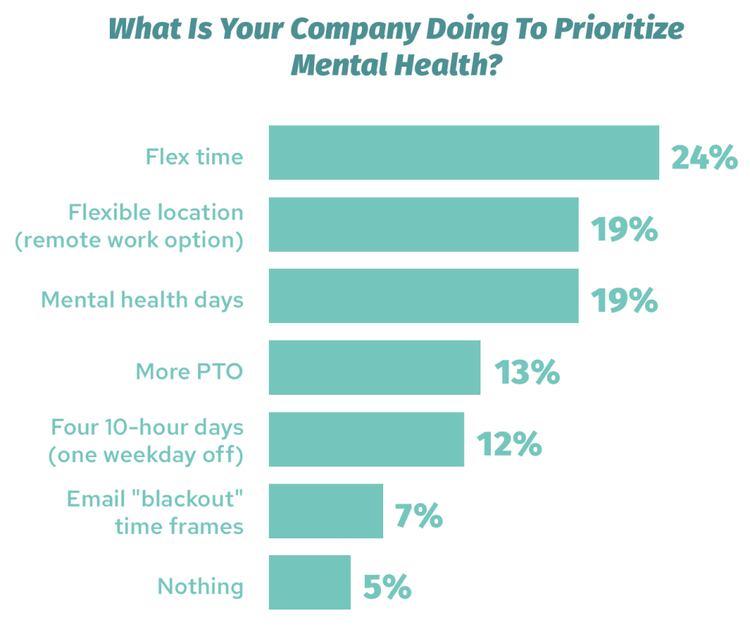The 2022 Essential Retention Guide

The State of Retention in 2022
The Great Resignation: Fact, Not Fiction
Empoyees are quitting in droves–it's not just a rumor. According to the U.S. Bureau of Labor Statistics, a record 4.5 million Americans quit their jobs in November 2021 alone.
In our own survey, 45 percent of respondents said that the current trend in departures at their company was higher than usual. A whopping 81 percent, however, said that resignations have had a negative impact over the past year. Broken down by company size, it seems larger companies are seeing the highest rates of more than usual departures.
Whatever’s causing this issue to hit large companies harder, organizations across the board are having a difficult time keeping their best employees with their company.

The Top 5 Reasons Employees are Leaving
To figure out how to prevent turnover in the future, you need to know why employees are leaving in the first place. We asked our survey pool of HR and business leaders why their employees were quitting and pulled out the top 5 reasons they reported hearing.
With better pay at number one, it’s clear that any retention strategy should include examining compensation and making needed adjustments to stay competitive. As essential as things like purpose, growth, and challenge are to maintaining engaged workers, at the end of the day, employees are working to support themselves and their families, and money matters.
Interestingly, many respondents reported that compensation has risen at their company over the past year.

Wellbeing in the Workplace
Losing large numbers of employees and finding replacements is tough on HR. A lot about the past couple of years has been tough on HR. So it’s sadly no surprise that 87 percent of the HR pros we surveyed said they are facing personal challenges. Among their top concerns are:
- Mental health
- Physical health
- Financial health
So, as you look to create an effective retention strategy, don't forget about the people being asked to lead the charge. (That's you!)
If you’re feeling burned out, at least your HR and leadership peers understand what you’re going through. 40 percent of those we surveyed said they’ve thought about leaving their current role because of burnout. 31 percent said it’s because there’s too much to do and not enough time, and 21 percent said they aren’t feeling valued.
(Sounds like you all deserve a vacation—and a little more recognition!)
In the end, HR professionals and leadership are ready to jump ship for the same number-one reason everyone else is: better compensation.

Investing in Retention
Reducing turnover rates and bouncing back from The Great Resignation starts with making an investment in retention. Our survey data found that many companies are already seeing the need for this and making that shift.
And what does the investment look like among those we surveyed?

4 Ways to Boost Retention and Minimize Turnover
1. Make employee satisfaction a priority.
Satisfied employees are more likely to stay with your organization. Your retention strategy should start with discovering what your employees actually want—asking for their feedback, listening to understand, responding in a way that ensures they feel heard, and then acting based on their feedback.
Many companies are already asking for feedback from their employees. However, more than half of respondents report that their company only sometimes makes changes based on employee survey responses.
It’s understandable that organizations don’t always jump immediately into action after every survey—budget, bandwidth, and business priorities often stand in the way. But it’s worth a reminder: if you don’t address your employees’ concerns, they may be less likely to give honest feedback in the future. Ignore them too long, and they may start hunting for a new job instead of seeing the potential for change at their current company.

2. Conduct honest exit interviews.
Employees leaving your company might have some of the best insights into what your organization could do to improve retention. After all, they have nothing to lose by being honest. But not everyone takes advantage of this potential source of information—in fact, only a third of the leaders we surveyed said they consistently interview departing employees.
Having real data from exit interviews can help you make changes with real impact.
3. Rethink your benefits strategy.
With so many organizations moving to hybrid and remote work models, in-office perks like stocked kitchens have lost their luster. Our survey showed a clear understanding that compensation, lifestyle, and wellbeing benefits are highly appreciated.
Don’t know what your employees want when it comes to benefits? Ask them—not just about what benefits they’d like, but what wishes and worries they have now and for the future. Hearing what matters most to them can help spark ideas for unconventional benefits and identify gaps in your current benefits strategy.

4. Address employees' mental health and wellbeing.
If 87 percent of those in the survey said they’re stressed about their wellbeing, it’s safe to say that those outside of HR and leadership are probably feeling the pressure, too. Between changes caused by COVID-19, coworkers leaving, and general unrest around the country over the past several years, employees have plenty to occupy their minds. How organizations are creating space for mental wellness and recovery covers a broad spectrum.
With an investment in retention and an increased focus on the employee experience, HR professionals and business leaders can make a comeback from last year’s high turnover rates. Listening to your employees and acting on and responding to their feedback and concerns will help you create a retention strategy that has 2022 turnover numbers looking significantly less stressful.
